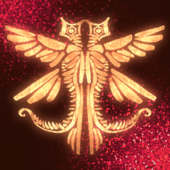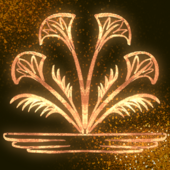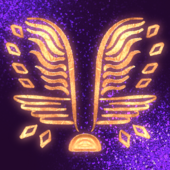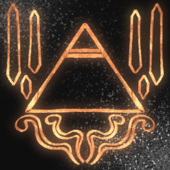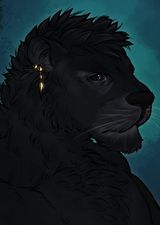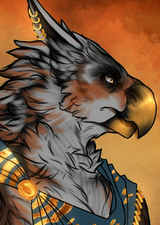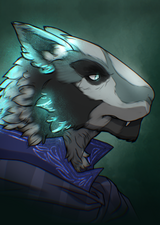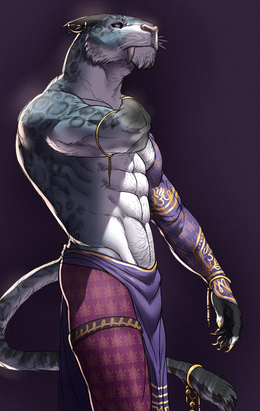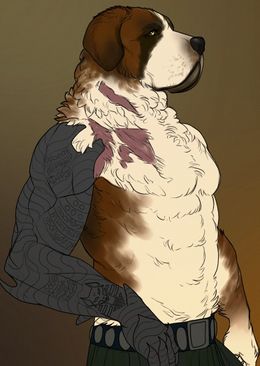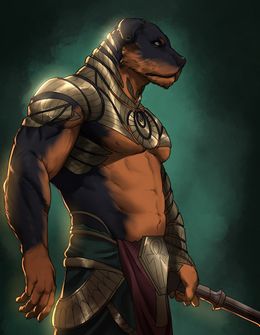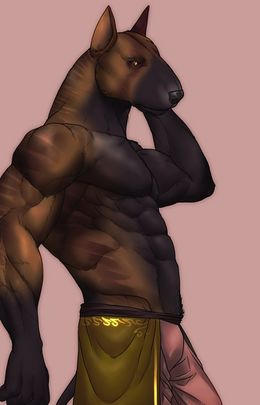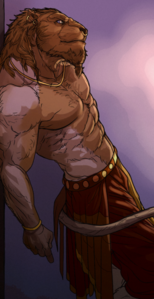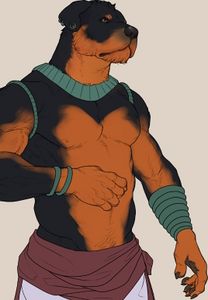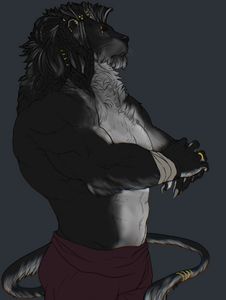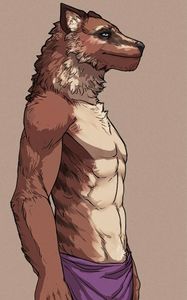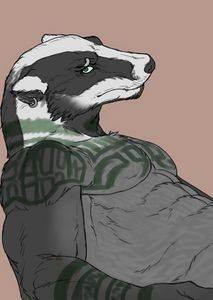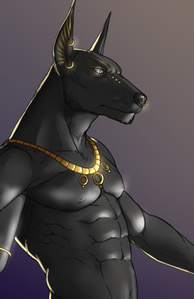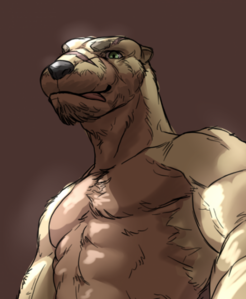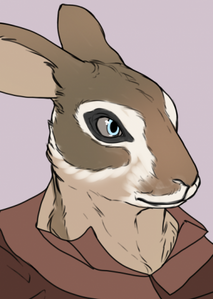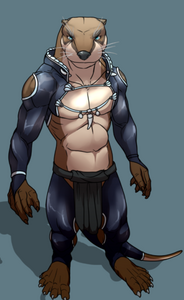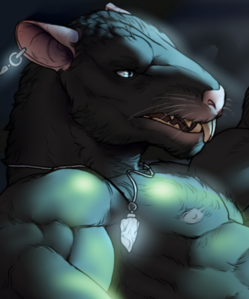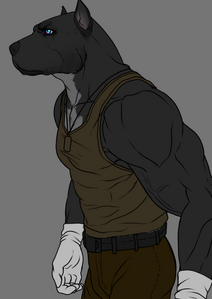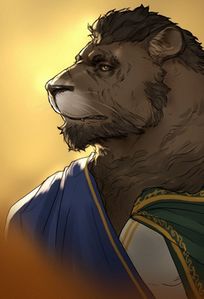Asha
| Asha | |
|---|---|
|
| |
 | |
|
| |
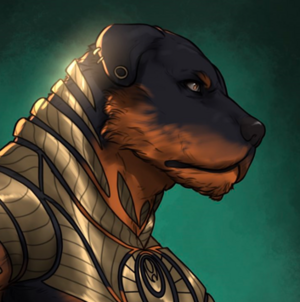 | |
| Nation State | The Ashal States |
| Ruler | N/A |
| Other Present | N/A |
| Languages | Ibeth, Common |
| Religion | Baskarr |
| First Recorded | 20,000 BC |
| Demonym(s) | Ashal |
The Asha are the oldest continuously existing People on Aloria, even pre-dating the Elven Allorn Empire, though has undergone massive changes throughout history. Under the early Dewamenet Empire, the Asha were poised to conquer vast parts of the world, however they came into conflict with the just-founded Allorn Empire. A cataclysmic war of Dewamenet Technology versus Allorn Magic erupted, which the Dewamenet lost. The surviving Dewamenet were enslaved by the Allorn Empire and used for tens of thousands of years as magically bound servants, while their Empire collapsed and their cities turned to dust. Despite Elven attempts to eradicate their culture, parts of it survived through being passed down within bound memories, and some Elves who were sympathetic to their fate. When the Allorn Empire collapsed under its own weight following the last Void Invasion, many Asha violently rose up and overthrew their Elven masters, establishing states of their own, and reconnecting with things from the past. In the modern day, the Asha are still very much affected by their millennia of servitude, with many of them having taken to the seas to attack Elven ships, try to free still enslaved Asha brethren or turn to Regalia to discover parts of their past lost to time. The Asha are a people that are slowly rediscovering their past in the world, and for many, to discover how the past has defined them and how they will define the future of all Asha.
Design
The Asha are a collective of anthropomorphic animal-people, the closest approximation of a "Furries" on MassiveCraft. A wide range of animal types are available, from canine to equine to feline, to marsupials and more, with some species classified under separate Lineages (see below). The Asha can have plantigrade legs and feet or digitigrade legs and clawed feet and hands. They can have a wide variety of natural eye colors, as well as natural fur or feather colors and patterns, but there is a great deal of freedom to change, for example using leopard fur patterning for a canine-otter hybrid design. Some unnatural colors are also available to some of the Legacies. It is important to also mention the Half-Asha, who the Asha consider full members of their societies. Half-Asha are Asha born from dominant Asha parentage that show Asha traits. Common appearances are for example animal-like eyes, ears, claws, tails, and legs, but mostly without fur covering their skin.
Cutures
Asha are divided over four so-called Lands which loosely determine their cultural associations and beliefs. This is an important choice for most Asha (though many are born in them) because it defines their outlook on life, and most notably how they interact with Elves and Mages. Historically Elves and Mages have inflicted a lot of pain and suffering on the Asha, and so the Cultures define how they act around Elves, and how they treat Mages. It is possible to change Cultures over the span of Roleplay, but choosing one is recommended when beginning a new Character so that others understand how they feel about certain topics, without the Character having to explain complex and potentially nuanced points of view for every Asha they meet.
|
Deshret which loosely translates to the red land, are Asha unified in their hatred and search for justice for the pain and historical trauma their people have suffered by the Elves. Deshret Asha can be found all over the world, but most numerously among the Corsair Fleets and Naval Nations, populations of Asha without a true homeland to call their own. Deshret Asha can be expected to always express hostility towards the Elves, and anything related to the Allorn Empire or the institution of slavery, often being at the forefront of the breakdown of this dark institution in the Empire, or agitating for the Regalian Empire to go to war with the Allorn to crush them. Deshret Asha always remember their historical suffering. |
Hedjet which loosely translates to the white land, are Asha who are still marked by the suffering of their people and cooperate with those aiming for liberation but aren't obsessed with hating Elves. While they can be cautious around Elves, it is not unthinkable that they would befriend an Elf or prioritize other matters in their lives than the destruction of the Allorn Empire. Hedjet Asha hail mostly from the Ashal States, island nations where the Asha try to rebuild their culture peacefully, but have also largely moved past their societal trauma, preferring to look forward to better times than to relive the suffering of the past millennia continually. The Hedjet might be derided as tone-deaf to the suffering of their people, but would quickly retort that it is in fact the others who will themselves in an endless cycle of reliving their trauma with their obsessions. | ||
|
Neferu which loosely translates to the beauties or the beautiful land, are at best tolerated by Deshret and Hedjet Asha, and at worst considered enemies. The Neferu Asha are Asha who have embraced Magic despite its usage to inflict so much pain on their people in the past, or Asha who belong to the Silontaar people, Asha who have made Magic part of their biology. The Neferu mostly hail from the Silontaar city-state, but have populations in many nations, even those still captive in the Allorn Empire. Neferu have a similar attitude to their collective history as the Hedjet, having largely moved on from the trouble of the past. Though, they deal with new demons in the present, and guilt over their people's inaction when their kin were eradicated by the Elves. |
Kemet which loosely translates to the black land, are nearly universally reviled or feared by the Deshret, Hedjet, and Neferu. They include three distinct populations. First Asha who have abandoned their cultural heritage and started worshiping Evolism. Second the Asha who have gone mad with grief and become death cultists who worship the death gods and thus also embraced Death Magic. Finally there are the Mystech who were once Asha, having been ripped from the land of the living or their Dewamenet afterlife when the old Baskarr God stole the afterlife, and used it to invade the Evolist pantheon. In doing so, he became a Void God, but all Asha who joined him or were taken there became Void Spirits. Kemet Asha have a complex and often hostile relation to all others because they are disconnected from the modern world. |
Heritage Traits
When designing a Character, Proficiency Points allow for a limited Ability selection with Point Buy Packs. Heritage Traits adds free Packs and Mechanics on top of that to help with cultural themes. Free Packs grant Abilities usually, while Mechanics change the way a character functions in Roleplay through subtle, and usually out of Combat ways. In essence, Mechanics just add aesthetic flair that invest in the niche of each culture. Free Packs never raise Proficiency Points, but the character must be able to purchase them normally. (ex. if a character is a certain Affinity that locks them out of a category, they cannot take that specific free pack and must choose the alternative option.) If a Free Pack grants Magic of some type, that Magic can be of any Alignment the character can normally choose, or limited to a select alignment, which will always be written in the Free Pack description. Mixed Heritage characters (i.e. characters born from two parents of different Cultures) may take one parent's 'Free Packs' and mix and match up to 5 Mechanics from both parents, although some Peoples cannot produce Mixed Heritage children (due to Magical/Fantasy reasons). Half-Asha must still choose a Lineage to be matched with, and can only pick and choose Mechanics from that Lineage.
Free Packs
- Asha can choose 1 Pack from any Category for free. If any magic is chosen, the player may choose an Alignment between God Magic, Exist, Ordial, Void, and Dragon Magic.
- Asha can choose 1 non-Ability Pack that is not Magical or Religious in nature. Non-Ability Pack means that it must be a Pack that does not give a Combat Ability.
Lineages
There is a great deal of physical divergence among the Asha, though four major Lineages are considered categorically similar. While all Asha receive the same Free Packs, what Mechanics they receive is dependent on the Lineage they belong to. This choice cannot be changed, and is also relevant to determine the physical characteristics of the Character. It is possible to be a mix of Lineages, but only one Lineage must be chosen for Mechanics. Lineages have no bearing on Cultures, a Remet Asha can belong to Kemet or Deshret culture, and so on. Some caution should be exercised with Silontaar Lineage however, as while they could in theory claim to be Deshret Asha, because they are biologically Magical, other Deshret Asha may reject them.
|
Remet Asha | |
|
Mechanics
|
|
Savent Asha | |
|
Mechanics
|
|
Silontaar Asha | |
|
Mechanics
|
Language and Naming
The Asha speak a language called Ibeth which is based on real-life ancient Egyptian. However, it should be noted that because Ibeth is considered a reconstructed language from archeological evidence, that it is an incomplete language, and takes a lot of loan words from Common (English). Also, because it is a reconstructed language, not all Asha naturally speak Ibeth, as it is only really taught in the Ashal States and the Corsair Fleets. Most Asha who are born in Regalia never learn Ibeth, and more commonly speak the other languages of the Empire. In terms of naming, Asha similarly either have modern Ailor names or Elven given names if they were born in slavery, but many Asha have also started embracing Ibeth naming practices. Based on ancient Egyptian, these names can be complicated, because most online resources just re-iterate the names of priests and pharaoh's without discussing the names of the common people. Here follows some examples of how to construct Ibeth names with the information we have within the lore.
Baskarr based naming
Baskarr based naming refers to a common habit for a person to be called "Son of X" or "Made of Y". These are honorifics given at birth and end up being used as first names, but can also be adopted at a later point in life to honor a specific God of the Baskarr Pantheon. Even Asha who are not Baskarr faithful can have these names, because the Baskarr Gods doubled as divine individuals as well as secular rulers of the Dewamenet Empire. It is also common for Asha in the Regalian Empire to have both a Baskarr-based name, and a more common name used among non-Asha like a nickname. This naming process is complex, and requires a lot of trial and error. If you need help, you can make use of a [spreadsheet] we have provided to simplify the process, or inquire in a ticket. The current known Gods are Tjafar, Akhet, Khannar, Divi, Ra'mut, Wadjat, Nehet, and Hemnetjeret. Common name prefixes are: Sahu (spiritual body of), Sa or Si (son of), Sat (daughter of), Mose or Mes (born of), or Menkau (established in the soul of). Then, either the first or last syllable of the Gods is used to compose names, for example for Tjafar, these would be "Tja" or "Far", while Ra-Mut's syllables would be "Ra" or "Mut". Names can either be single words, or have a hyphen (-) to separate the syllables. Thus, finally composing a few name examples:
- Sahutja would be "the Spiritual body of Tjafar"
- Sat-Kha would be "daughter of Khannar"
- Menkau-Ra would be "established in the soul of Ra-mut"
- Narmose would be "born of Khannar", except the syllables are switched around.
- Rasa would be "son of Ra-mut", except the syllables are switched around.
If you need help composing a good name, please make a Ticket. It is perfectly acceptable to source names from the internet, please just try to avoid naming your Character Imhotep or Rameses or Tutankhamun, or such like familiar names from historical people. Generally speaking you should prioritize names that are easy to pronounce and not too overcomplicated long, while feeling unique to your character. Surnames are not common in Ibeth, though a frequent way to identify someone is by using the "of placename" suffix. This can either be existing cities in the Regalian Empire (or even Regalia), but is more commonly cities in the Ashal States, of which here follows a short list: Akhiza, Siwakhet, Nasar, Lunet, Lahun, Per-Wadjet, Tjebu, Zwajet, Akhet-aten, Bubaskarr and so forth.
Brief History
The Lost Era
The Lost Era defines a period during which the Asha referred to themselves as Dewa, based on the state name Dewamenet. As Dewa, the Asha were the preeminent Empire of the time, which a high technological progress, though recent archeology and events in Regalia implicate the Empire as being tyrannical towards its neighboring people, and even to its own subjects. What little is known of this Empire, was that Magic was strictly banned and any born Mages were killed. The Empire frequently invaded neighboring countries to enforce this anti-Magic policy, which eventually led to conflict to the rising Allorn Empire This Dewamenet-Allorn war became all-defining for the next 20,000 years, as it destroyed the Dewamenet Empire, the wholesale genocide and enslavement of the Asha, and the rise of the Allorn Empire as the undisputed magical hegemon of the world.
The Dark Era
The Dark Era defines the period during which the Asha were scattered by the diaspora, with hundreds of millions existing in the cruelest of slavery conditions among the Elves who held no esteem or value for their lives. During this period, the Savent and Silontaar Asha also hid from the world, the former by closing of all connections and communications with the east, while the Silontaar erected magical shields to isolate their city state from the world outside and turned inwards. Next to no information exists from the Dark Era, because the Allorn Elves expended great effort to eradicate any and all Asha cultural heritage sites or knowledge. They frequently blew up the ruins of Asha cities, or magically wiped the memories of the people so that they would forget their history, and continue to be pliant serviles. The Dark Era ended when the Cataclysm rocked the Allorn Empire and cracked it open. The Asha in the north and east rose up against their Elven masters alongside the Ailor, and threw off their shackles of slavery.
The Light Era
The Light Era is, despite its beginning with the slave revolts in the northeast of the Allorn Empire, perhaps a bit of a misnomer. While many Asha now live free from slavery and oppression, only a small portion of the Asha population ended up escaping from Allorn control, while the majority was just inherited by the various successor Elven states. While the Regalian Empire has embraced abolition and feed millions of Asha from its Elf-inhabited regions, many Elven states will hold tens of millions of Asha in bondage, while only a few million free Asha live in the Ashal States and the Corsair Fleets. The Corsair Fleets in turn continue to raid the Elven countries in an attempt to free their brethren, while the free citizens of the Ashal states and in Regalia attempt to uncover more of the past to piece together their broken culture and revive it.
Conflicts and Alliances
A lot of MassiveCraft's lore is constructed around conflicts that are based on religious, historical, or societal grievances. This section aims to set out the various conflict and alliance points for the Lanlath, while also attaching some nuance so that there is wiggle room for players to not get stuck in endless loops of arguing the basics of societal conflict without clear Character Development or Resolution.
- Elves: All Asha have a complicated relationship with any type of Elf, even those who have no historical claim to Allorn slavery, or were already removed from the Allorn Empire before the Dewamenet Empire was destroyed, like the Suvial (because they still do slavery of a kind). While not all Asha want to outright murder all Elves, there is certainly a large portion of them that will, if given the chance. There are however also Asha who do tolerate and even fraternize with Elves, so it always remains a mixed bag.
- Ailor: Ailor are both a great ally, and great hindrance to the Asha reconnecting with the past. There has been no people more useful to the Asha in terms of allying against the Elves, and aiding in the reclamation effort, yet at the same time, some Ailor are the greatest obstacle to the access Asha might have to their legacy, by hoarding Asha artifacts in private collections, or claiming ruins and not letting anyone in.
- Maraya: The Maraya have recently become a steadfast ally, both due to the fact that they have a historical connection to the Meraic Empire, but also because both of them have had to suffer the loss of Empire and history and complete destruction. There are many similarities between the historical experiences of these two people, and so they make natural allies.
Religions
- Baskarr The most obvious and majority religion for the Asha is Baskarr, which was once an ethnoreligion for them, but is slowly being rediscovered to be so much more, and inclusive of other peoples.
- Unionism is the second most common Religion for Asha, especially those born in the Regalian Empire. The Asha are represented by Asha Gods in the Unionist Pantheon, which makes it very appealing.
- Estelley Any Asha who worships Estelley is deeply, deeply strange. Estelley as a religion was used to justify the genocide of the Asha, and is an Elven ethno-religion, so there is no compatibility.
- Fornoss There are some Fornoss Asha communities, particularly in Nordskag where some Asha communities fled after the destruction of the Elven Empire, and integrated with the Fornoss Ailor.
- Evolism Evolism is a surprisingly common religion among Asha, especially those who court the Dark Gods for powers to take vengeance on the Elves, or just support Gahan and his Dream-Dewamenet.
- Draconism Draconism does not have a strong Asha representation in it, but Asha can be Draconists if they resonate with the dogmatic virtues or mechanical themes of world-creation in Draconism.
Culture
This section covers Remet Asha Culture as it was known from rediscovered or surviving customs from the Dewamenet. There is overlap with the other Asha Lineages, but niche cultural habits like fashion are discussed in their Lineage Expanded lore further below.
Fashion
Asha clothing is often very simple in its application of garments yet rich in texture and patterning. Beyond a simple chest cloth worn by women and leather straps worn by men to attach objects to, most Asha rarely wear any clothing on their upper body when they don’t seek a reason to blend into other societies. On their lower bodies meanwhile, all wear a so-called Satoor, a dress-like clothing piece often in earthen or burgundy color tones with a variety of intricate patterns in vibrant colors that spans from the waist to the ground. These Satoors are often specially tailored to allow a tail to protrude from the back, and also have individual cuts on the front and sides to allow a free range of motion for Asha in combat. The Satoor is, in fact, a crucial piece for many cultural traditions of the Asha. As part of decoration for the Satoor, high officials may also wear shoulder capes or shoulder pelts from Muff-oxen. Jewelry is also a very much prized accessory for all genders of Asha, with numerous necklaces and ear piercings being the norm in adults. The Asha recognize the difference between a civilian Satoor and a combat Satoor in that combat Satoor cut off at the knees, while those for civilians end at the ankle or a bit higher. The Asha also have a fabric that was once unique to them alone, produced by the coastal Asha which has since expanded world-wide. Elastan, a form of lycra, is made from natural blue threads excreted by the unique coral species called Mewnes. The fabric is inherently liquid deterrent, and Elastan clothing made by the Asha usually covers their arms and shoulders, as well as their legs and waist, but does not cover their torso. Elastan was eventually also mixed with other fabrics, creating Peltastan, a form of wooly spandex. It has properties similar to those of Elastan, being form-fitting and soft, but Peltastan is not water repelling. Peltastan clothing is usually worn on the torso and upper leg area, while a half-Satoor is worn over it like a battle skirt, often with shoulder pads to boot. Such pads are often light and decorative, as Asha effectively do not wear armor, in order to benefit from their superior agility over other Races. When protection is required, Living Metal is capable of forming a quick, sleek coating for their defense.
Mannerisms
Mannerisms are small niche behaviors Asha might display in Roleplay that enhances their themes.
- Asha tails are immensely important, both physically and culturally. They are considered a deeply personal extension of the mind, with touch being extreme taboo without permission.
- Tails can also be used to indicate intent. Tails aiming up can be a sign of intimidation or taunting, tails swaying can be a sign of approval or liking something, while tails wrapping around legs can indicate fear.
- Tails can also be used to touch others, which is considered an intimate gesture. A tail coiling or stroking someone else's leg is considered a very forward non-verbal flirtation.
- Most (but not all) Asha use a form of guttural sound for communication also. Growling, and purring, though not barking, are part of the vocal routine of most Asha when indicating pleasure or displeasure.
- Pulling or cutting an Asha's tail is considered an extreme insult. Tail cutting is a common practice among Elven slave holders, with Asha seeking to replace lost tails with living metal.
- Asha treat half-Asha as part of their culture, so long as they have made an effort to be part of Asha culture. Half-Asha who belong to other cultures receive apathetic responses from full Asha.
- Asha transition between bipedal and quadruped movement for a variety of reasons, for example while vaulting over things, or while crawling under obstacles, or to move around faster.
- Asha dress style is very much non-gendered. All genders wear the Satoor (a half-dress with a parted opening on the side), while female Asha may opt for a chest binding if it is culturally appropriate in Regalia.
- Asha are highly sensitive to the killing and eating of members of their people, as Baskarr holds that people who are refused by the afterlife, are reborn as wild animals in Aloria, such as lions or dogs.
Expanded Lore
Expanded Lore exists to apply more content to the Savent and Silontaar Asha, whose culture differs from the Remet Asha mostly discussed on this page, as well as other concepts that may be relevant to Asha roleplay or deep-lore exploration. This section is optional reading, though if you play a Silontaar or Savent, reading at least their sections is encouraged.
Gahan and Kemet
Gahan and Kemet are some of the recently most complicated aspects about the Asha experience. Gahan was once a god of the Baskarr pantheon, but under mysterious circumstances left said Pantheon, taking the Dewamenet afterlife with him, and breaking into the Void. While doing so, he used the Dewamenet afterlife and all the souls within as an army to effectively conquer a part of the Void, and crown himself Spirit Emperor, with all Void Spirits obeying his will one way or another. While the Spirits still wage war on one another, Gahan rules over the divided chaos absolute, and his Kemet Demons have a special role to play in his keeping the Dewamenet Dream alive in Kemet. Kemet refers to the Black Land, the name the Asha have given to this material afterlife that now exists somewhere between the real world and the Void. They consider it a black land, because anytime anyone has had visions or dreams of the place, it is always represented by a glowing black obsidian pyramid, in which Gahan sits on his throne keeping a fragmented memory of the Dewamenet Empire alive in the afterlife. In essence, while the Dewamenet Empire was destroyed, the capital and the afterlife merged and become one place, which was then tainted by the Void, though it did keep many Dewamenet alive for eternity while the rest of their Empire crumbled.
Gahan's Spirits in turn, are also playable. When designing a Mystech Character, it is recommended to paid Gahan loyalism/an Asha inspired Spirit as an Unbound Spirit. Gahan has several lieutenants, most important of which are the cruel and wroth commander Senetaph who leads the military legions of Kemet, Satjaraf-en the administrator who keeps the historical records of the Dewamenet and Kemet, and Barubast the shipwright who controls the access point to Kemet and ferries souls in and out on the black river, a proverbial magical gateway. While these Spirits should always be played with immense trepedation to reveal any information about Kemet (because we cannot logistically reveal deep lore to only part of the player base), these Asha Spirits should endeavor to be pro-Asha and reasonably align themselves with the Asha community in Regalia, despite its potential opposition to their presence or public cooperation. For better or worse, Gahan's Spirits are a window into the past, and their master despite being corrupted by his lust for power in the Void, still holds a dear place in his heart for his people and their plight, and so many of Gahan's Spirits are exceptional Elf-killers and tricksters.
Both Baskarr as a faith, and Asha society culturally speaking, has a complicated relation with Sprits. Spirits were not overtly used to torment the Asha during the Dewamenet war or their subsequent enslavement, but are being inherently made of Magic, the stuff that was used to murder their kin. Spirits are unaccountable and unpredictable, and their pro-Asha attitude (at least for the Gahan Spirits) is at best fickle, with a Spirit perhaps deciding to murder some Asha it does not like out of boredom or a desire to consume its soul. Still, these Spirits can provide invaluable assistance or information to the cause, and even those who do not consider themselves part of the Kemet Asha cultural Land, might indulge in a bit of Spirit summoning or bartering just to get an edge on the Elves, who still have the upper hand because of their Magic usage.
Savent Asha Expanded Lore
Savent Asha would almost be considered an entirely different people by outsiders, but they are most certainly Asha, and hybrids of species-appearances between Savent and other Asha are part of their heritage too. The Savent Asha descend from a group of peoples that objected so violently to the war between the Dewamenet Empire and the Allorn Empire on the principle of non-aggression and not hating Magic, that they left the Dewamenet Empire in search for lands far away from either Empire, or Empires as a whole. The Savent at the time believed that violence was an inherent quality of Empire, and as such, people should avoid creating large geo-political powers. They settled in a largely (by Regalia) unmapped continent north of Guldar called Qelis, a temperate lake-rich land where the Savent have established 231 smaller Kingdoms and Republics that all live in perfect harmony, but are equally rather poor when compared to other countries around the world.
Savent Asha are without exception, either fully Avian Asha (think Eagle, Raven, Hawk, Owl), or a hybrid between Avian Asha and mammalian Asha (for example, an eagle face with long dog ears and cat lower legs but an Avian upper body and tail). All Savent Asha have beaks, and all of them have avian forearms and claws, while some of them have wings including regal plumage. Savent Asha are otherwise physically similar to other Asha and Asha Lineages, except that they will a visual niche that is not existent in any other heritage or culture, bar from perhaps the avian (Maquixtl Genos Form), who fall squarely in the terror-bird category only.
The major difference besides appearance niches between Savent Asha and all other Asha, is that their psyche is in essence completely devoid of all trauma that many other Asha suffer from when looking at their history and the state of their people across the world. While there certainly is empathy and pity from the Savent in the fight against the institution of slavery, there is an equal yet soft-spoken sentiment among the Savent, that the Dewamenet got what they deserved. The Savent rejected the Dewamenet-Allorn War in all its senseless brutality (from their perspective), and deem the outcome to have "occurred in equal measure onto the Elves, to be fed to the Dewamenet Machine as fuel and un-eager hands of forced labor". Many of them in essence claim, that whatever hardships would have befallen the Asha, would have been inflicted onto the Elves if the Dewamenet had won, and that this is not a unique victimization of the Asha, but rather a sign of the more widespread depravity and hubris of Empire-politics.
That is not to say that all Savent think that the Asha "got what they deserved", there is always a very fine line to walk between being genuinely empathetic towards the suffering of the Asha, and finding the right time to discuss the causes and implications of the actions of the Asha forefathers. The Savent insist that the Dewamenet were far from innocent, and engaged in equal measure of genocide as the Elves did, it just so happened to be the case that the Elves did it better (and faster). Savent can be genuinely included in interest groups who seek to discover more of their lost historical heritage and have very real passion and emotion towards the rediscovery of lost information. There remains however, the concern from other Asha, or the thought in the back of one's mind, that a Savent is only there out of recreational reasons, and can never fully understand what it means to re-discover a culture that was so violently destroyed by the conqueror. At the end of the day, Savent can return to their own unique culture that has flourished independently from a desire to return to the old Dewamenet.
Savent Culture is based on real-world Achaemenid period Persia Minor cultures (such as Lydean and Phrygean or other Anatolian Cultures of that period). However, because there is no real linguistic survival from this period, we use Achaemenid names for the people, but still use Ancient Egyptian as their language. Despite their cultural deviation, the Savent have held onto Ibeth, as well as Baskarr as a religion, even adopting the more modern interpretations as die-hard belief in their faith waned over time, and they had to ironically resort to the diluted oral survival of the captive Asha to fill the gaps. The Savent are a culture with a very strong emphasis on metallurgy, particularly working with noble metals like gold and silver, which form threads throughout their other customs and traditions. Music is for example also important to them, with several instruments being credited to their invention, and always finely decorated with in-laid gold and silver threading.
Savent clothing is far simpler when compared to the Asha Satoor with its complex patterns, relying more heavily on the opulence of all that sparkles yet having very vibrant but simple patterns. The Savent tend to lean more in the direction of pacifism or at the least non-violence, vowing only to act in self-defense. That being said, Savent can be ferocious fighters, especially with their sharp beaks and talons, and several Savent arena fighters have gained fame in the Regalian Empire for their ruthless tactics in the ring. The Savent have a more cultural streak than the other Asha, enjoying the finer things in life, and attaching less value to status symbols and vanity. It should be noted, that the metals that the Savent work with (and can create with their hands) are not actual Gold and Silver, but imitation metals like Electrum, which is why having a Savent friend is not a get-rich-quick scheme.
Silontaar Asha Expanded Lore
The Silontaar, unlike other Lineages, actually look physically different from most Asha, despite being related. The Silontaar are never quite canine, but never quite feline either, lacking clear identifying features. Their faces are elongated like that of canines, but their nasal bridge and forehead is one continuous undented line. Their nose does not have rough skin, instead being fur covered, with only the implication of nostrils appearing as two slits between the fur layers. Their chin is sharp, with a sharp jawline also, but many Silontaar have very fluffy neck and jawline fur that obscures these sharp features and make them appear more rounded. Silontaar ears can be pointed and elongated, or rounded like that of a bear, or half round and half pointed like that of a cat. They always point backwards, unless they are in a state of alertness during which they point up. The most notable aspect about the Silontaar that absolutely sets them apart from the Asha, is that they frequently have magical glowing fur areas, and their fur patterns are very wild and have many frequently unnatural colors to them.
Silontaar History begins with the collapse of the Dewamenet Empire, when the Silontaar outpost (called Silesha at the time) was cut off from the Empire. The Allorn were originally not aware of the Silesha outpost on the far continent of Oldtera, as they had at this time not yet developed cross ocean sailing ships, which the Dewamenet had. The Dewamenet were not a classical colonizing people, but had set up a mining base in Silesha, because the mountains had a rare mineral not available in what is now modern day Westwynd. When Silesha became cut off, the locals were suddenly deprived of their technological shipments, and much of their infrastructure broke down. How Magic exactly was imported into their society is unclear, though it is generally considered out of necessity, Ailor had not yet colonized the areas around Silontaar so there was nobody to trade with.
The Silontaar remained extremely isolated from the rest of the world as a stagnant micro nation, largely because the mining outpost once only had a few hundred inhabitants, and because they still feared genocide by the Allorn. They reasoned that by not expanding, the Allorn would be less likely to notice them, and so they could live in peace, ignorant of the world that didn’t even know they were there. Early encounters with Ailor millennia later were far from peaceful, with Ailor being quickly seen as an invasive species that sought to deprive the Silontaar who had meanwhile established a somewhat thriving city-state in the region. The Silontaar chose not to seek out open conflict however, and instead erected a massive magical dome around their city to keep out outsiders. The Silontaar region was thus declared dead space by the Ailor colonists who created the Carrhen kingdoms around them, ignorant of the magic learning and expansion that happened exponentially under that dome.
When the Silontaar came out of hiding some 3000 BC, they found the world in a pretty deplorable state. Their precursory magical scrying revealed the sad and abused state of their Asha cousins, who they thought had devolved into separate species from their once unified Dewamenet bond (though they themselves had also changed). The slow decline of the Allorn Empire was anticipated, but because the Silontaar had meanwhile developed longevity by feeding on Magic, they chose not to act and simply wait out the storm. Peaceful relations were established with their Ailor neighbors who nonetheless still kept their borders closed to the Silontaar.
Much of Silontaar history remained exactly that: waiting for something important to happen, until the Cataclysm happened. The Silontaar were shocked by this event and motivated to finally come out of hiding, cautiously venturing into the world to try and mend the damage done to both people and the land. Silontaar adventures outside of their homeland have risen and ceased with the global acceptance of Magic, usually anchored to how Regalia viewed Magic. There was some success early on, but Silontaar once again closed their magical shield when Regalia’s Azure Order started actively hunting and killing Mages. In recent years, with the more pro-Magic policies of both Dragon Worship Regulus and Emperor Alexander I of Regalia, the Silontaar have once more come forward, trying to help people learn Magic the proper way without hurting anyone or themselves, while also undergoing magical prestige projects to try and heal the land. For example, there is currently a notable effort made in the Sundered Lands to raise all the sunken cities back to the surface. Whether the Silontaar are capable of working with other Asha depends strongly on the individual. Many Asha consider the stain of Magic the very reason why the Dewamenet Empire was destroyed, which by extension causes some blame to fall on the Silontaar for adopting the weapon of the slavers. Still, the Silontaar follow the Baskarr faith, and their goals align in general with the other Asha, they too feel grief at the loss of Dewamenet Empire, and perhaps even guilt.
Gallery of Art
Asha are really cool and awesome, and lots of art has been made of them.
Trivia
- There is credible evidence to suggest that the Asha along with the Meraic were the second people to make it into the upper terrasphere of Aloria and install the equivalency of satellites in orbit, but all knowledge of how they did this has been lost to time.
- There are a total of sixteen Corsair Fleets in operation across Aloria, but five are most notable among their number. These include the Medes Fleet led by the unique dual leadership of Ladies Saalamun and Vasnaf, the Sefetjew Fleet led by Lord Kahnef or “Lord Demon-claw” and the Kheni-Hetef Fleet led by Lord Ammunakhonet, an Undead warrior who has led his fleet since it was created nearly three centuries ago.
- Asha are routinely subject to accidental racism in Regalia, either due to over-familiar expectation of animalistic behaviors or similarities, or because Ailor try to be comedic with them, and end up comparing them to domestic animals. Don't do that.
| ||||||||||||||||||||||||||
| Accreditation | |||||||||
|---|---|---|---|---|---|---|---|---|---|
|
| ||||||||
